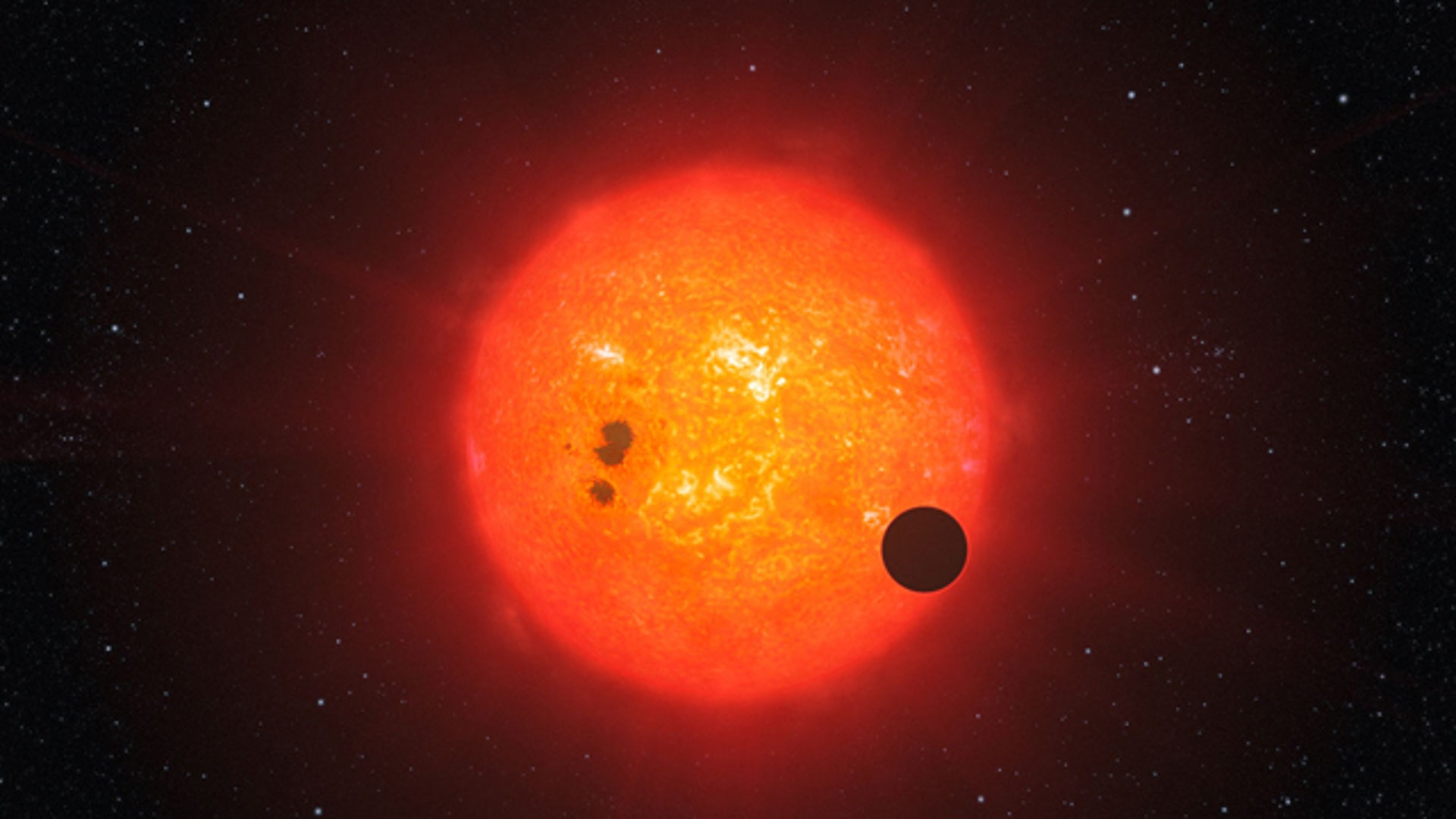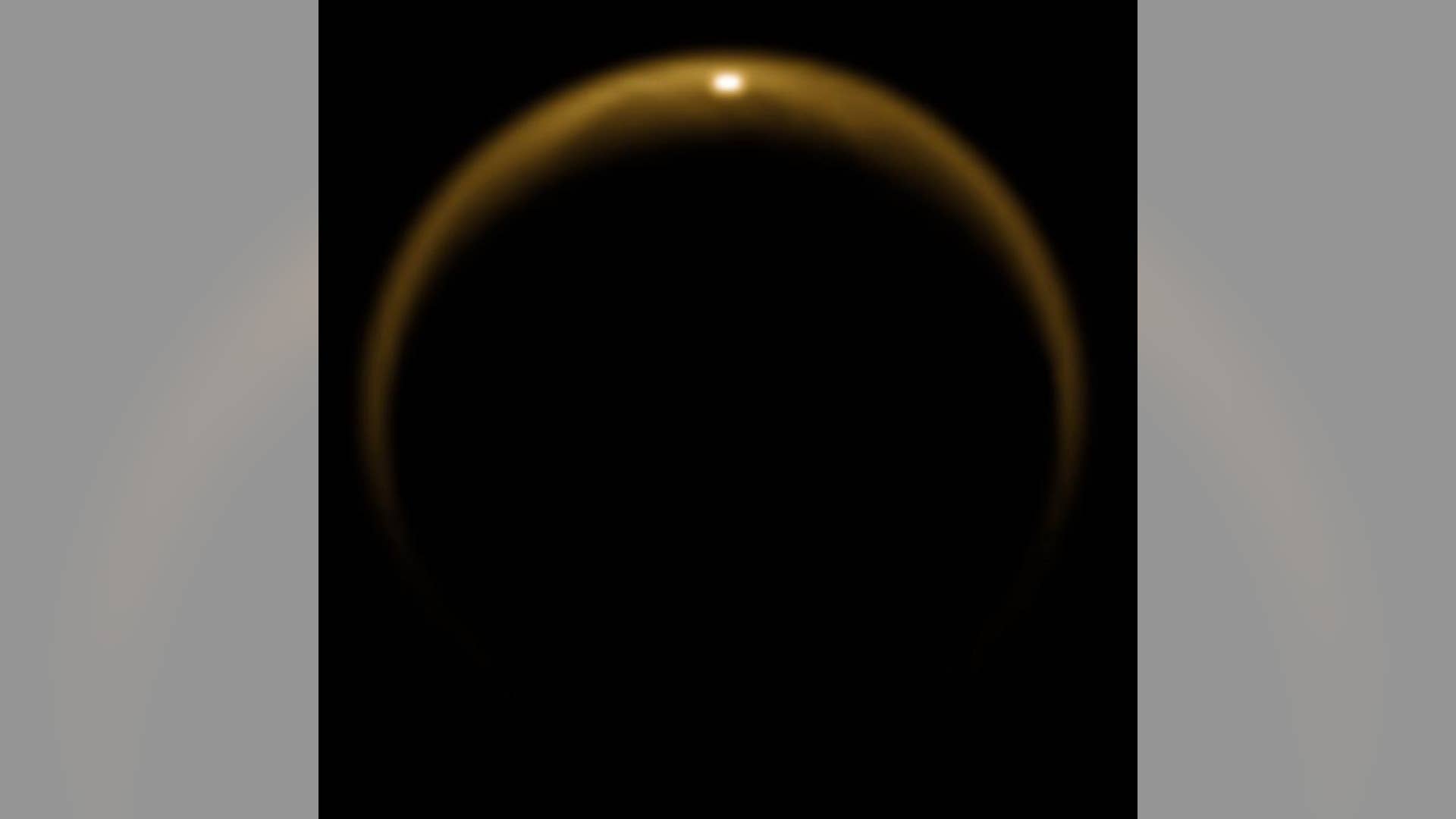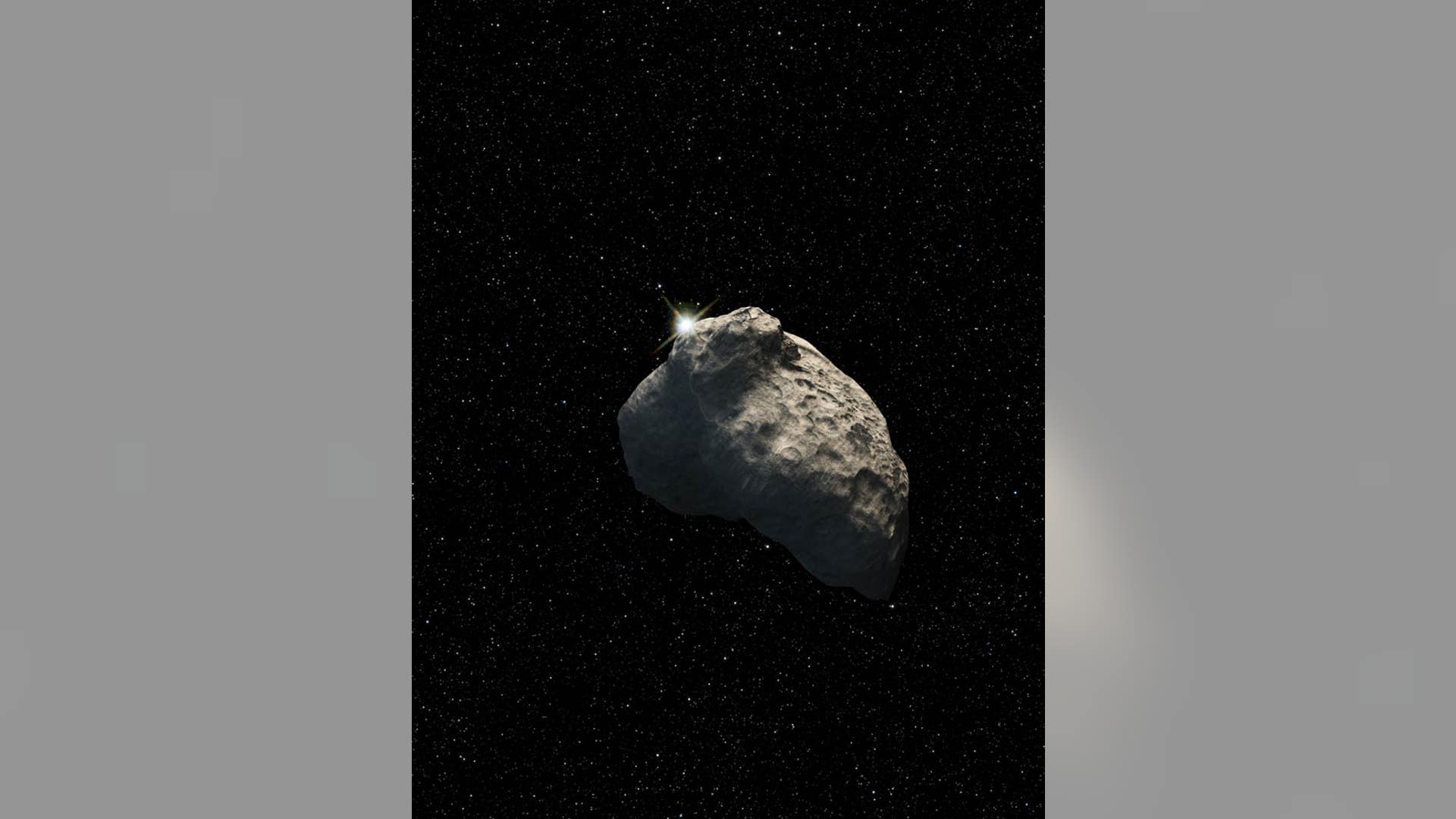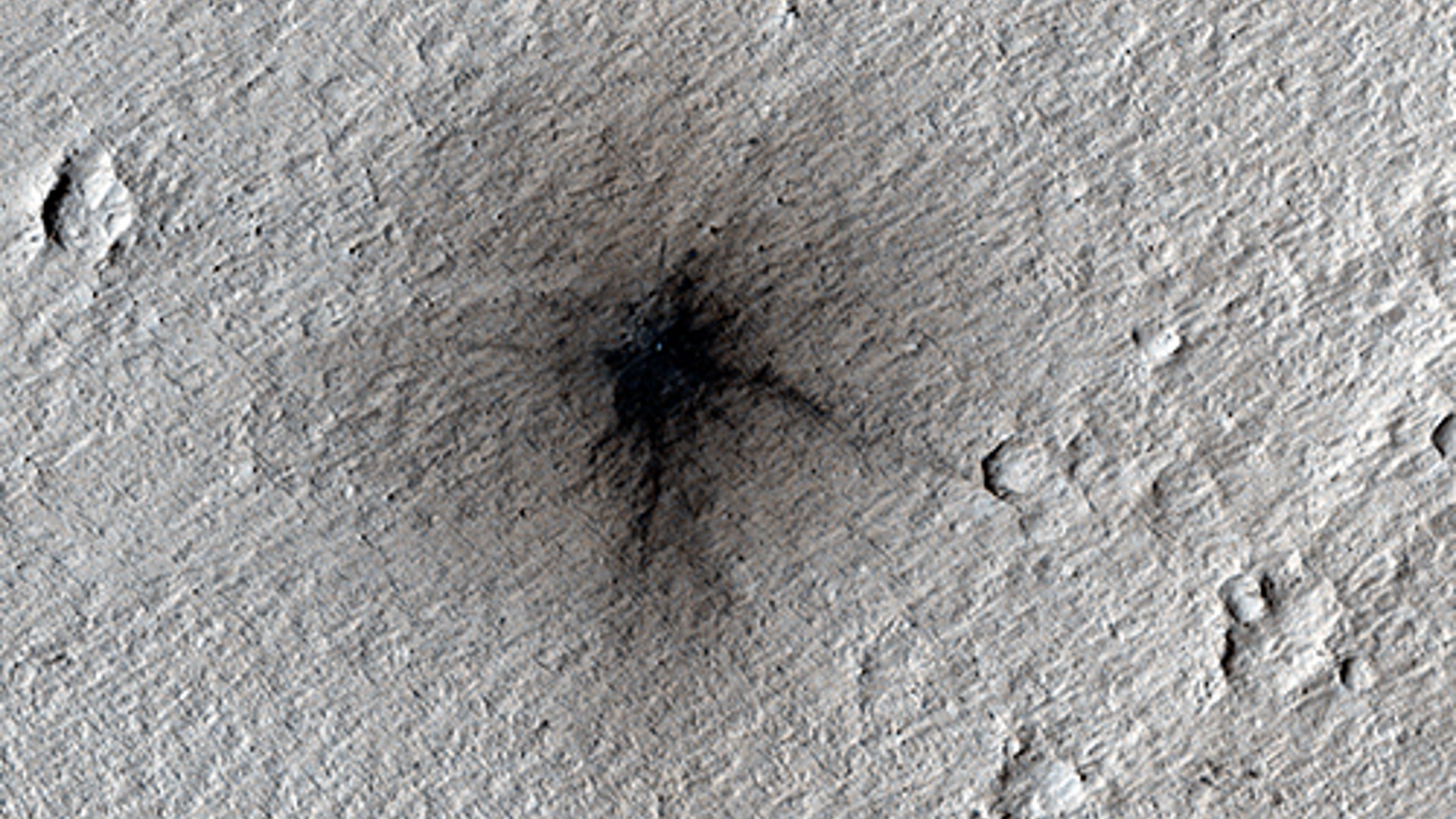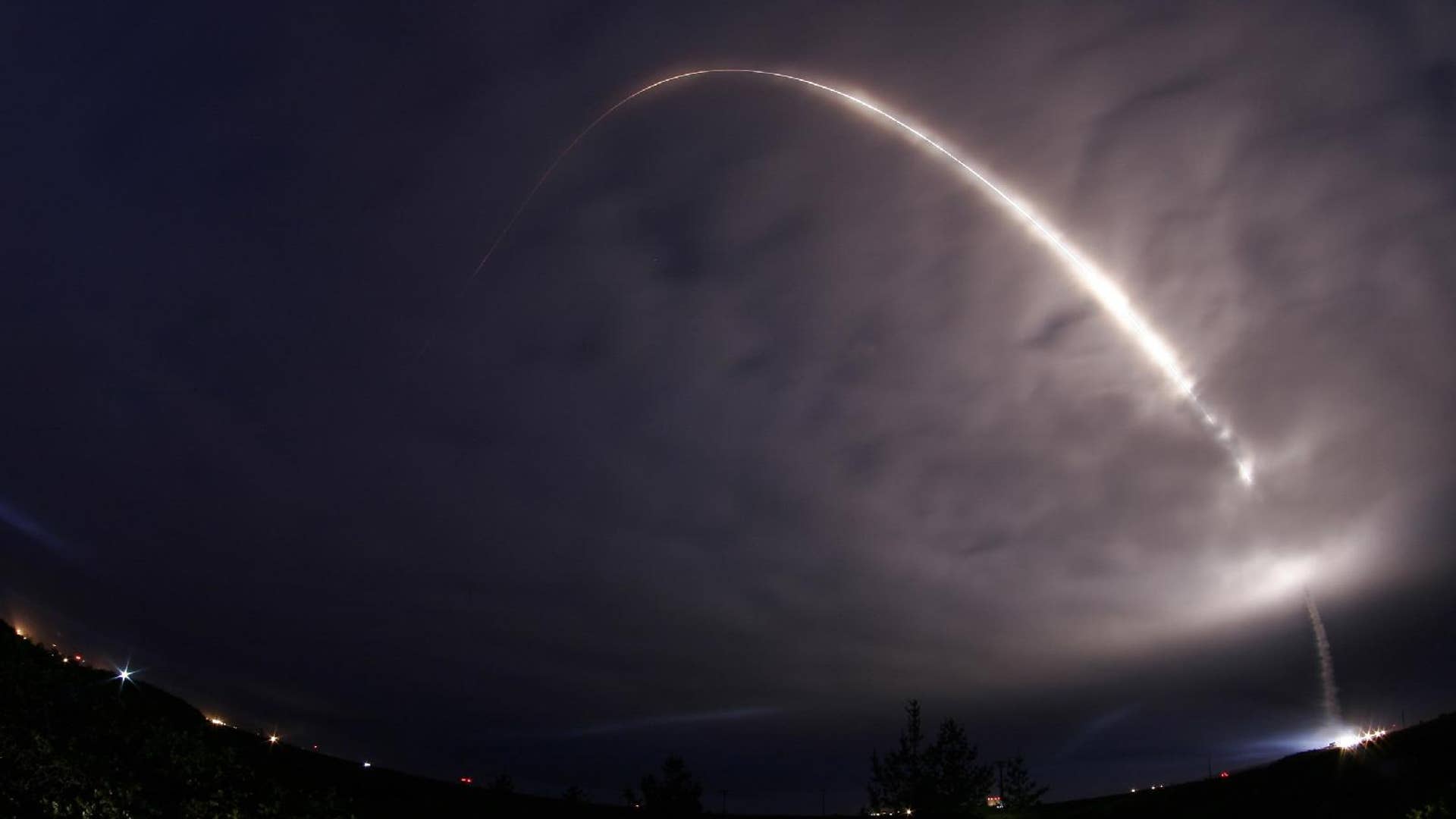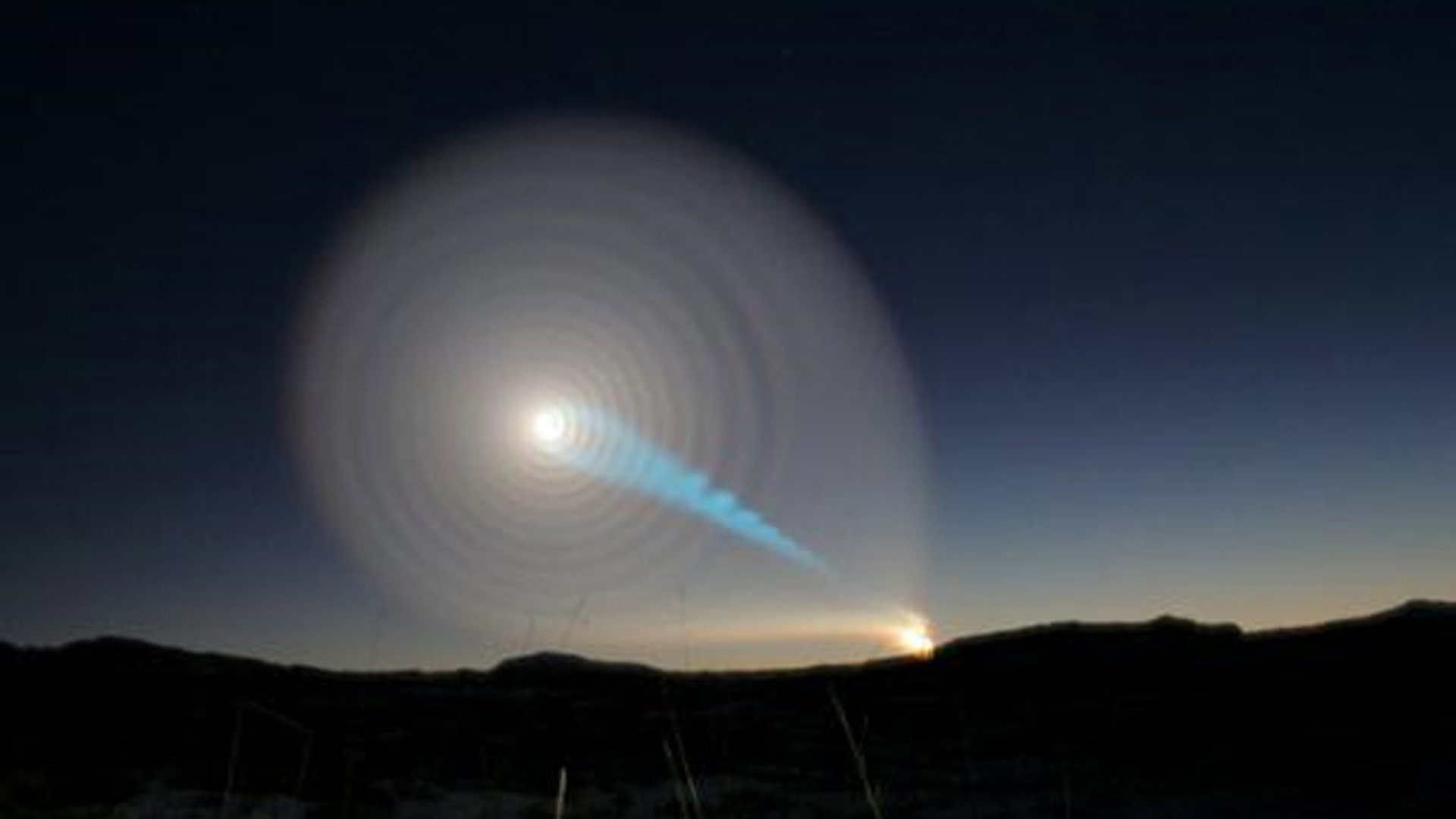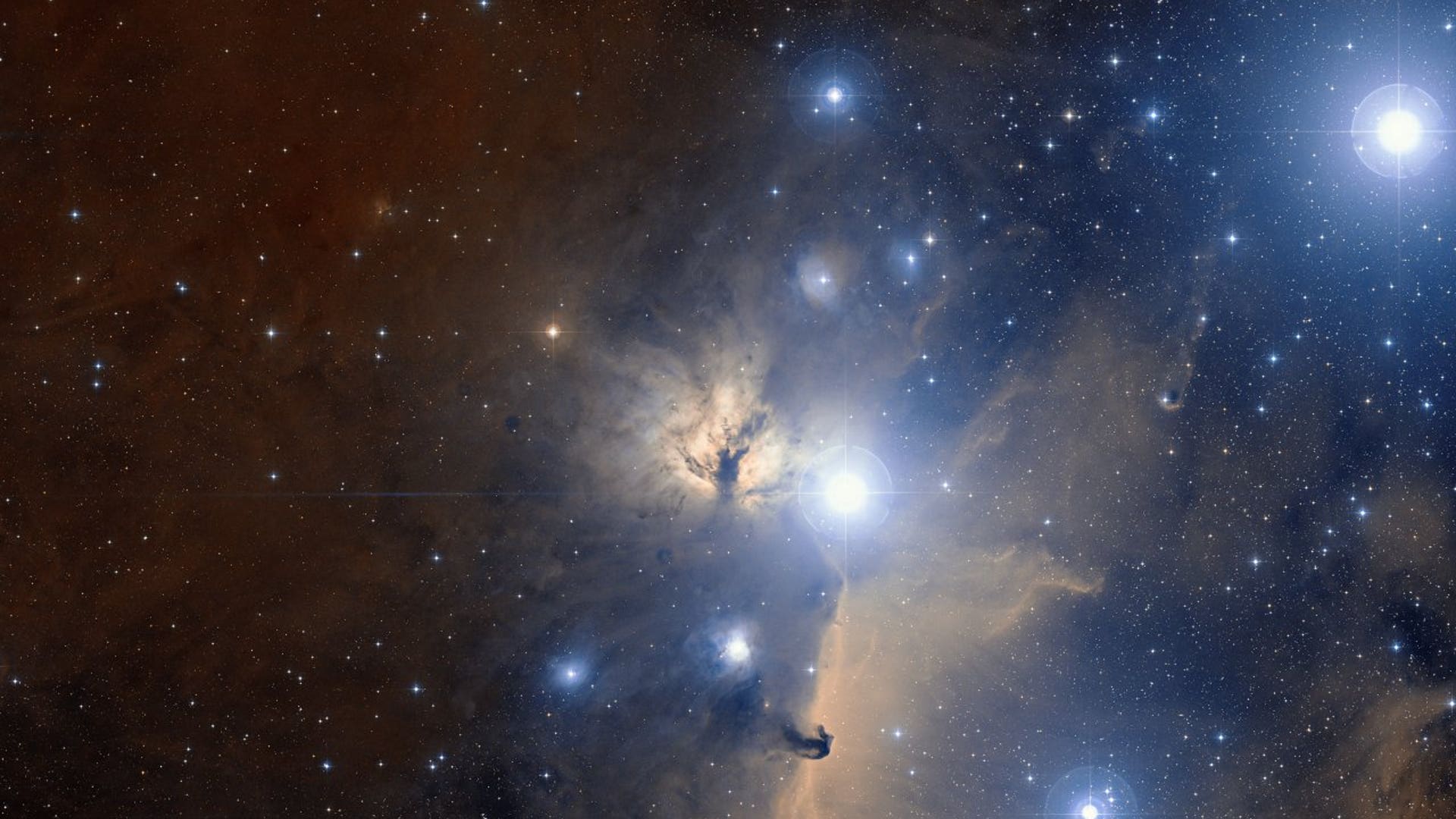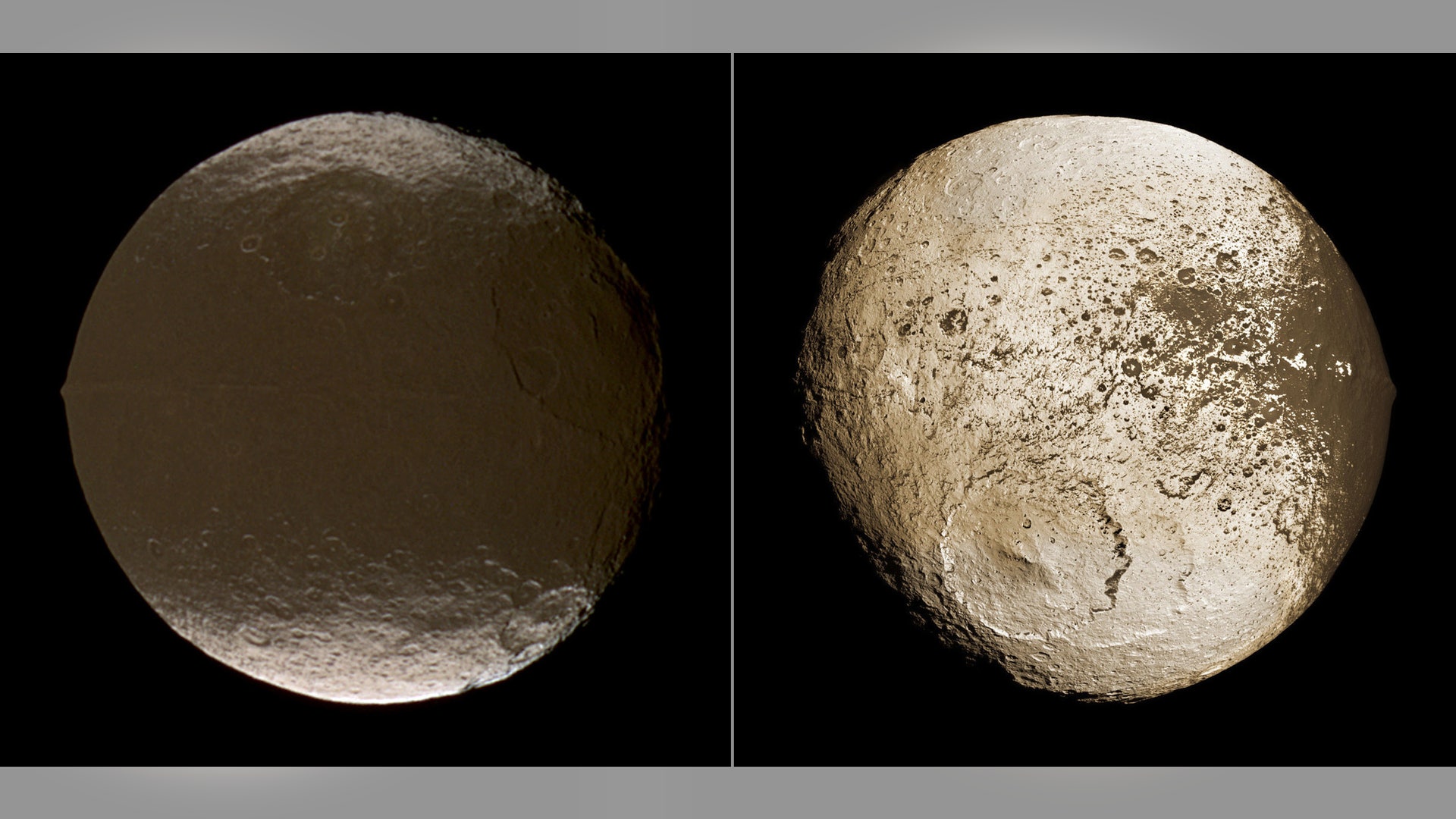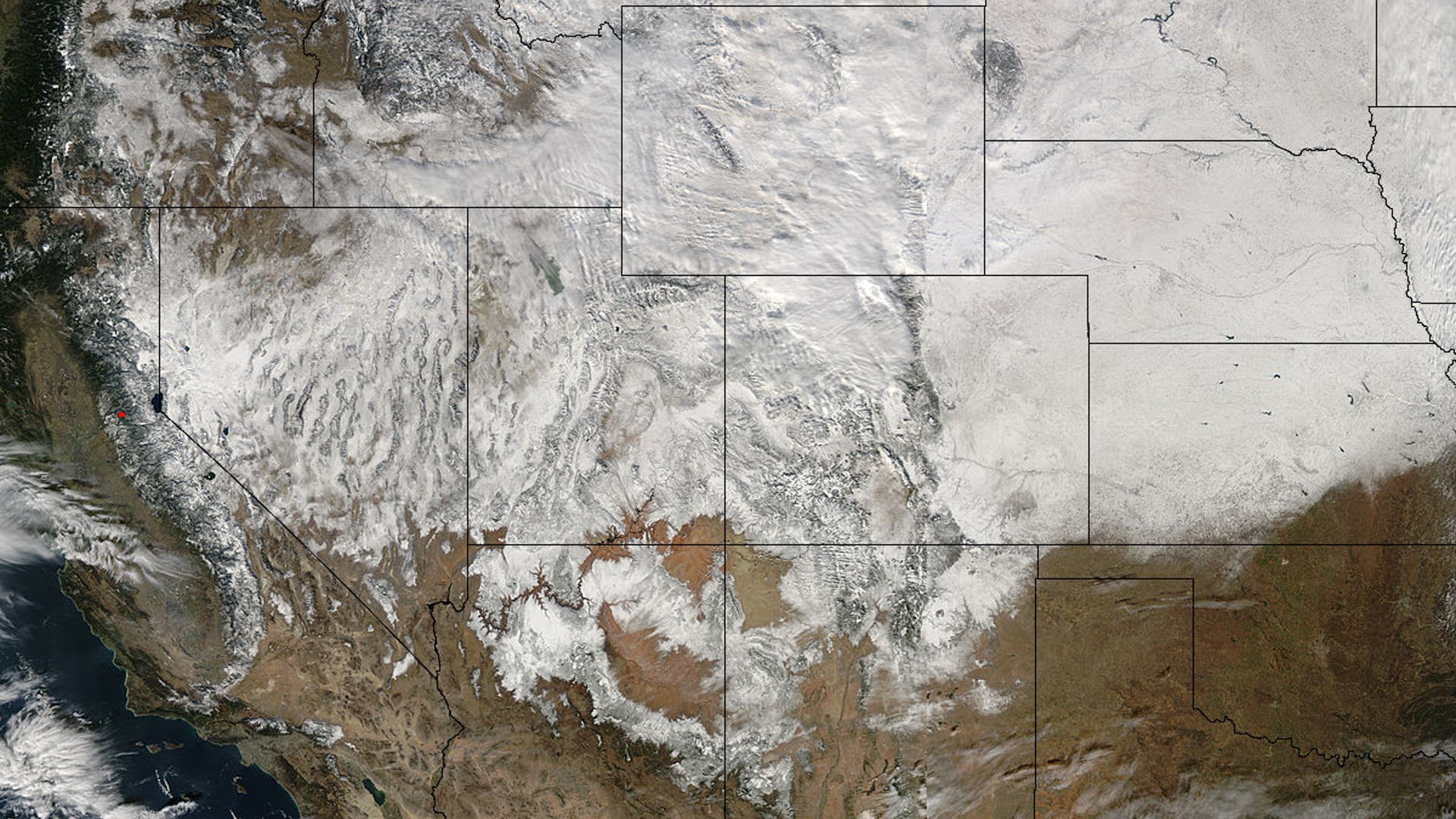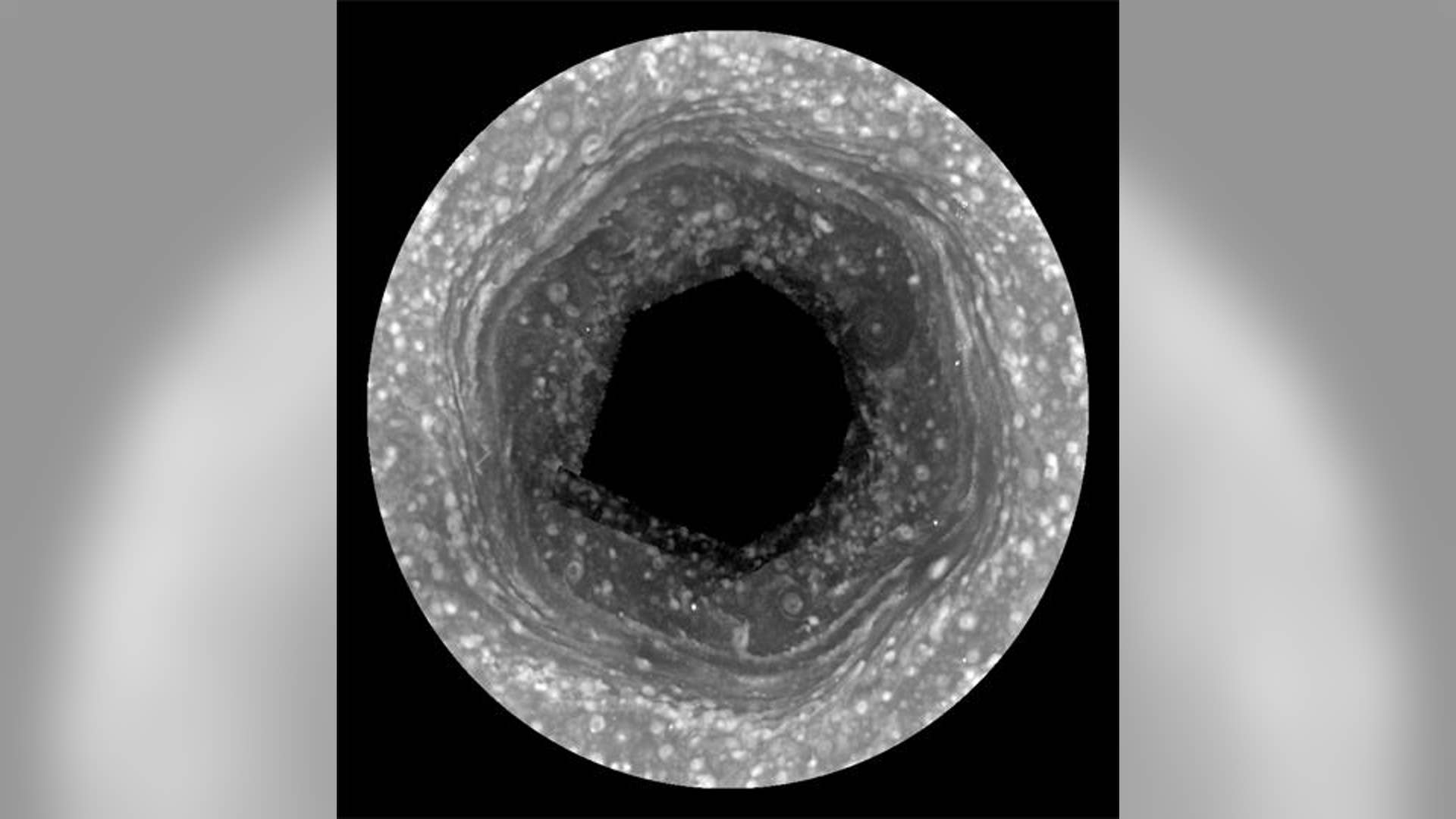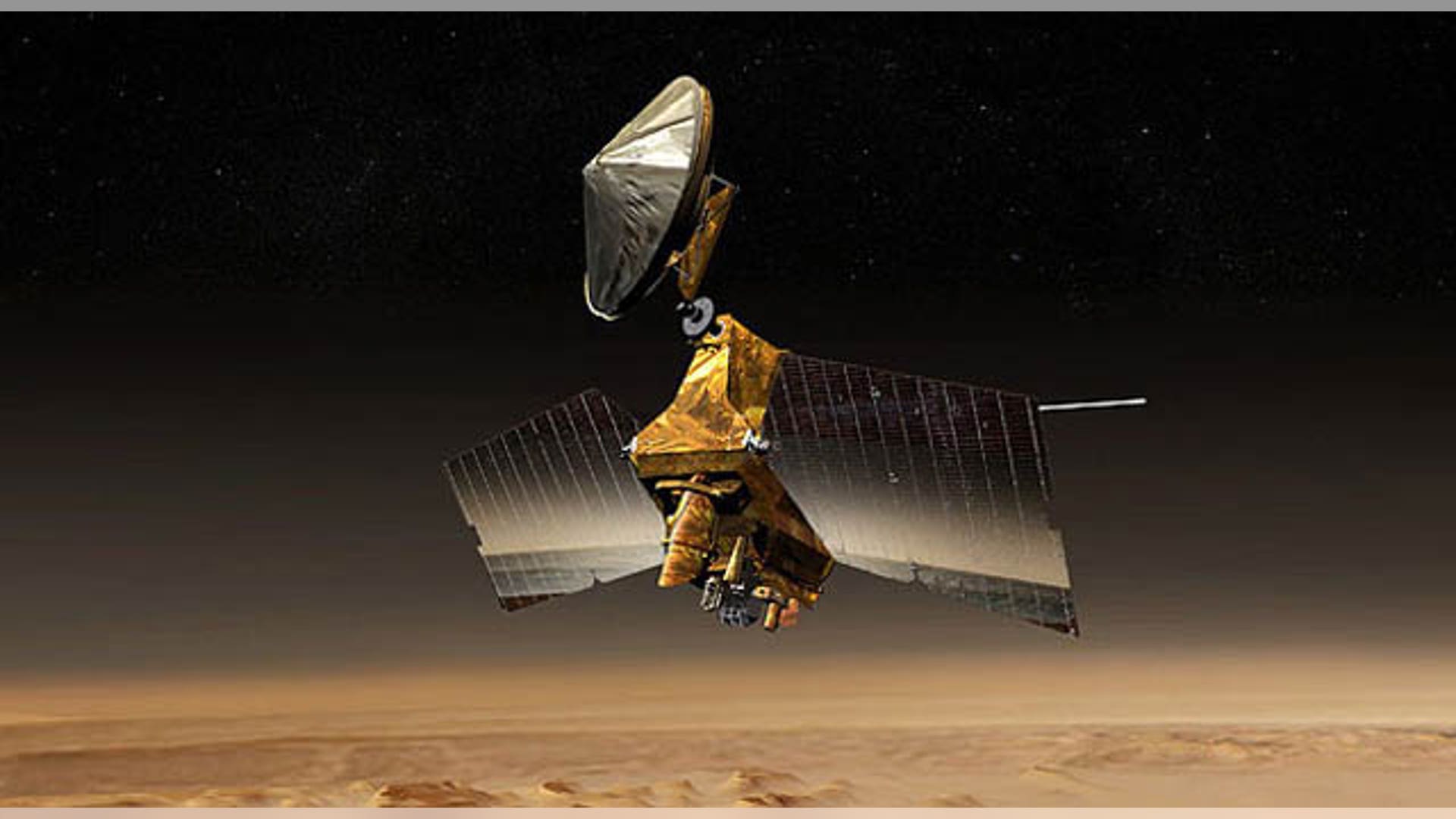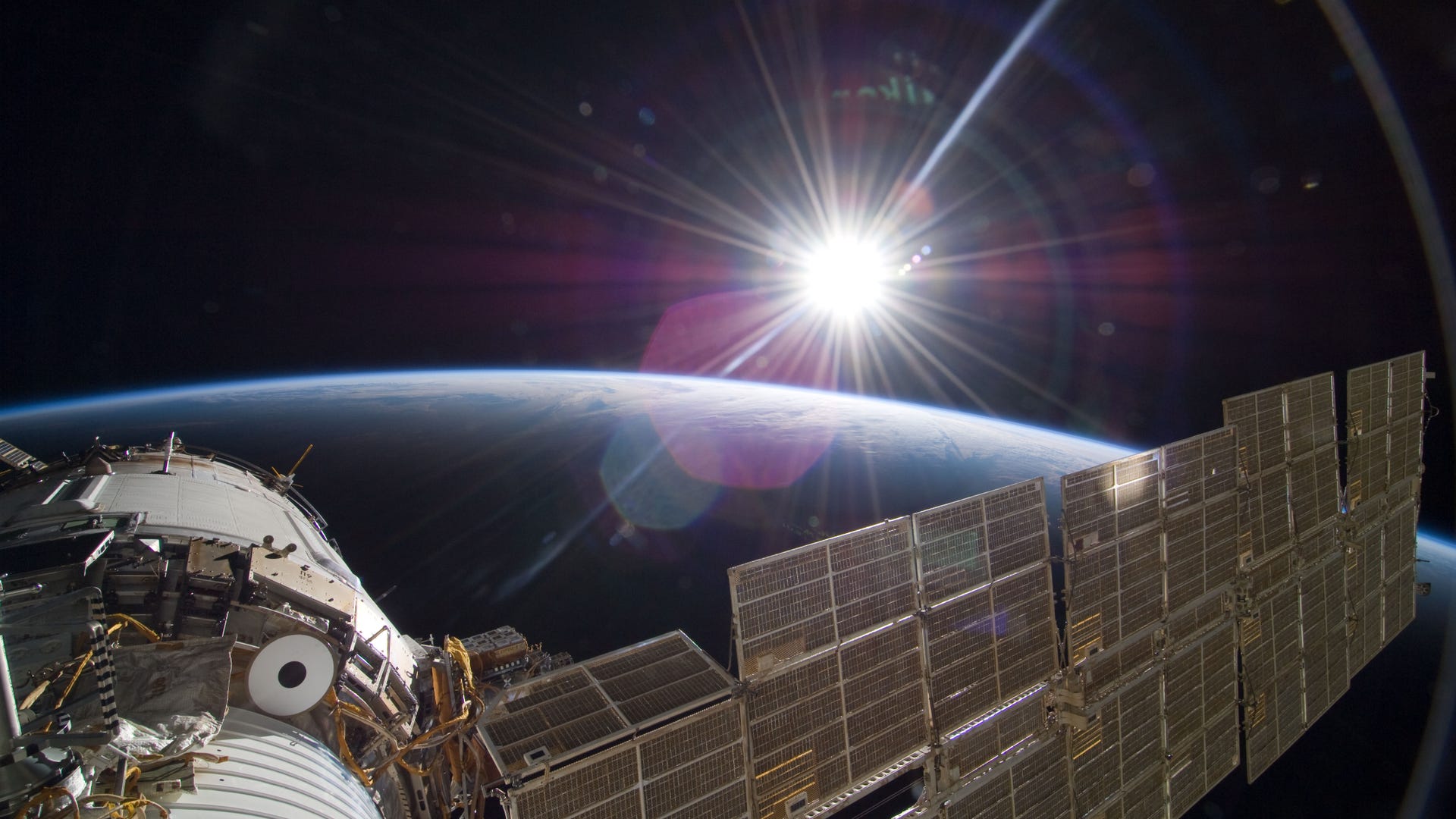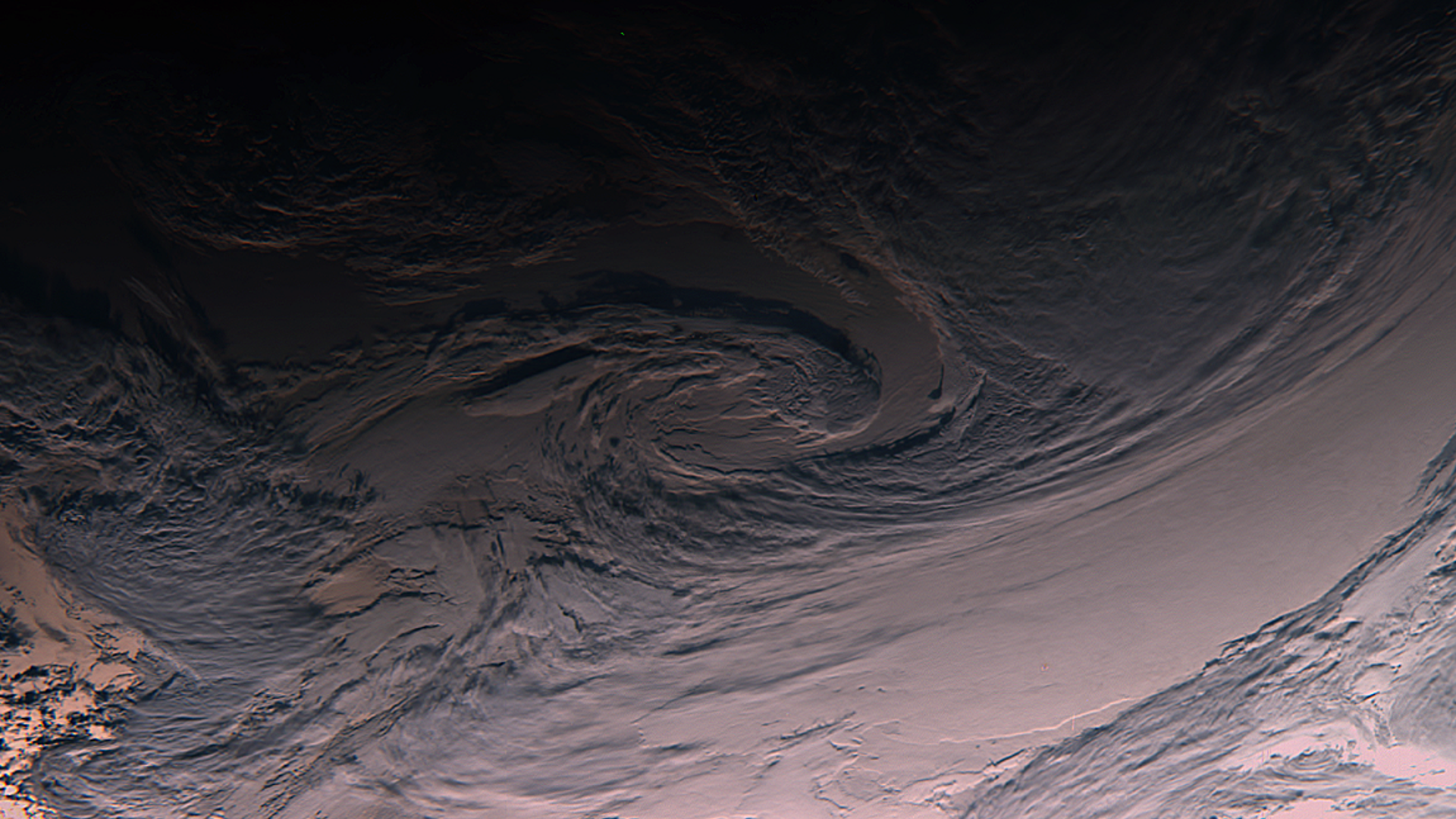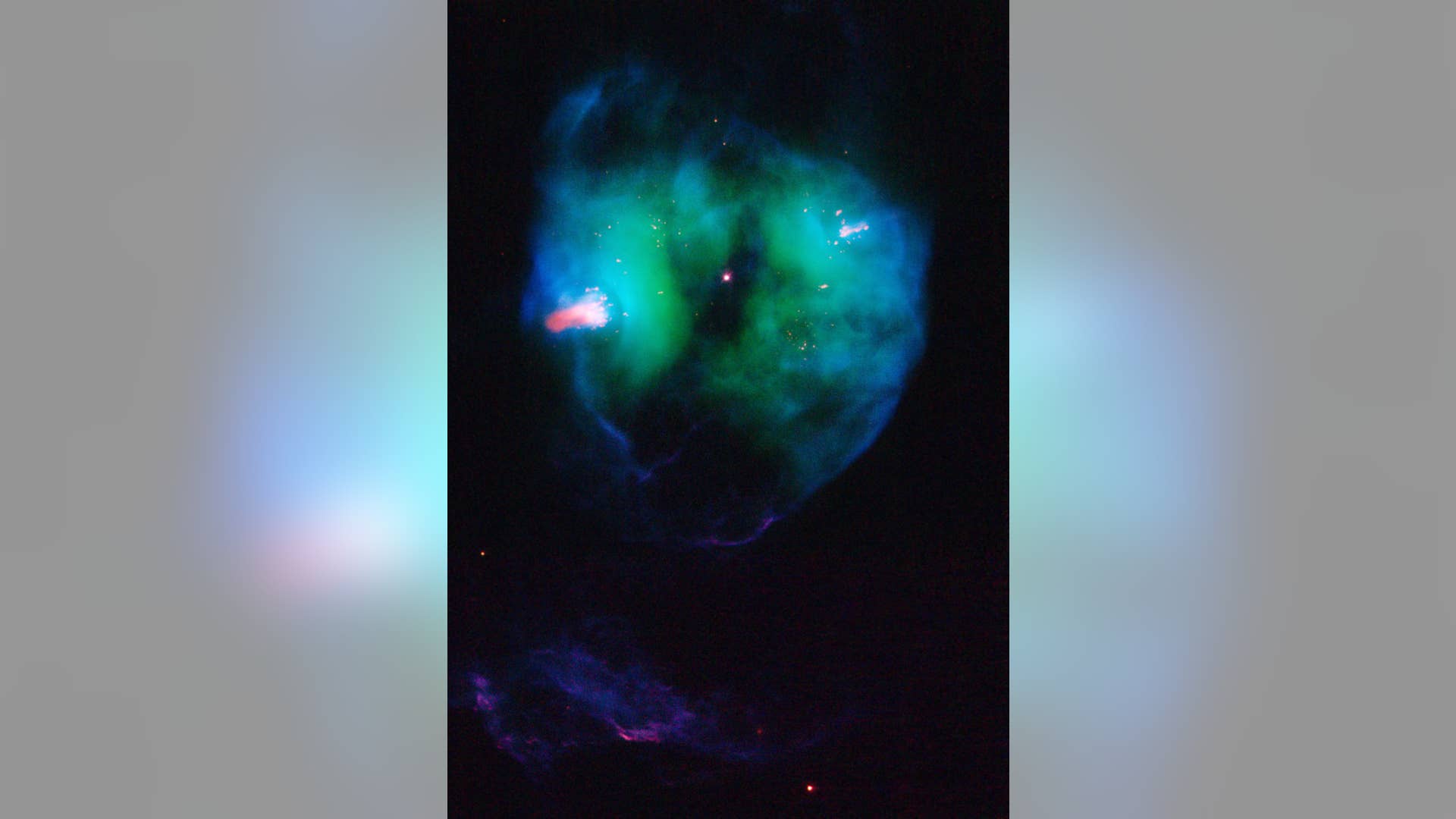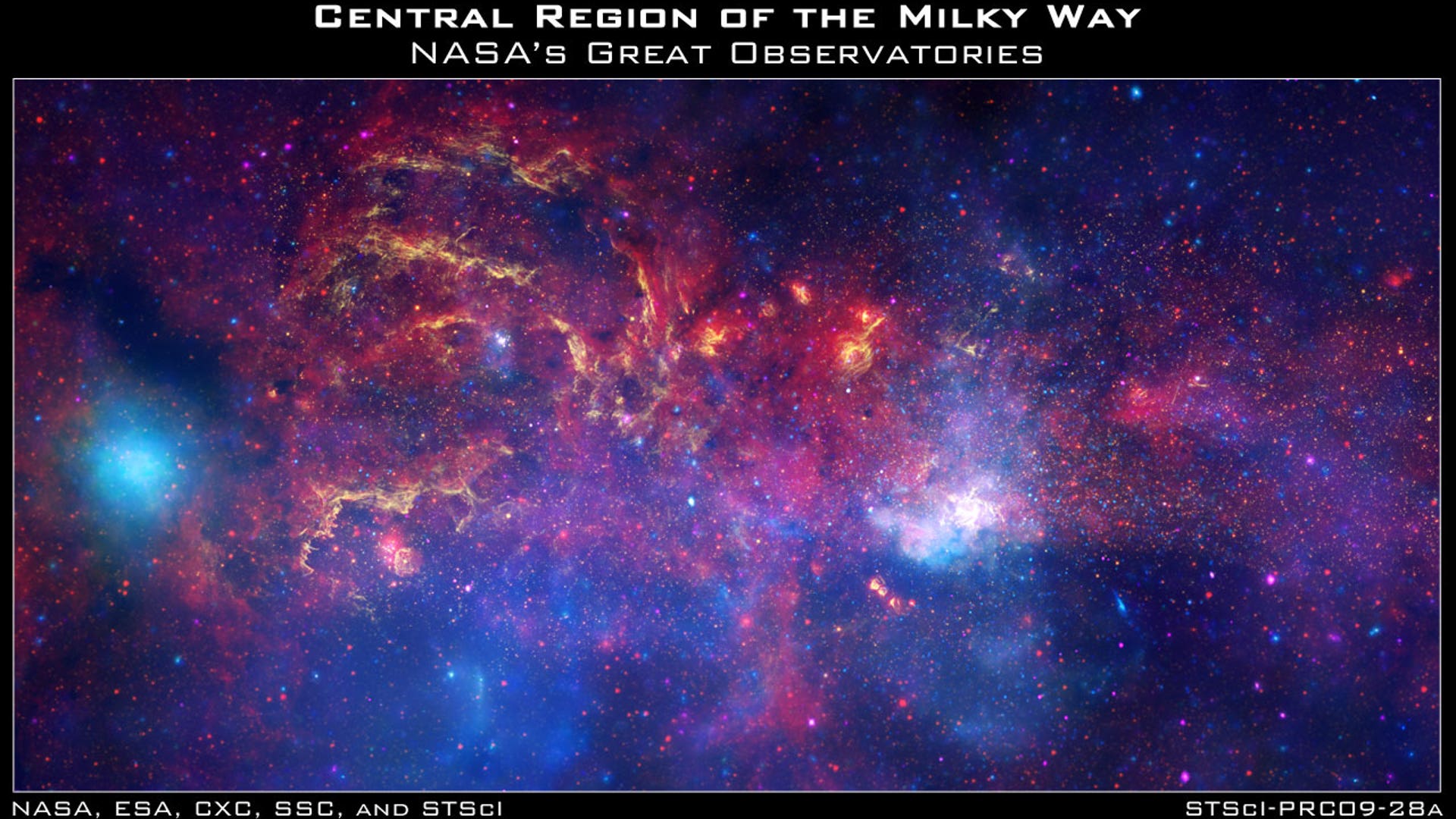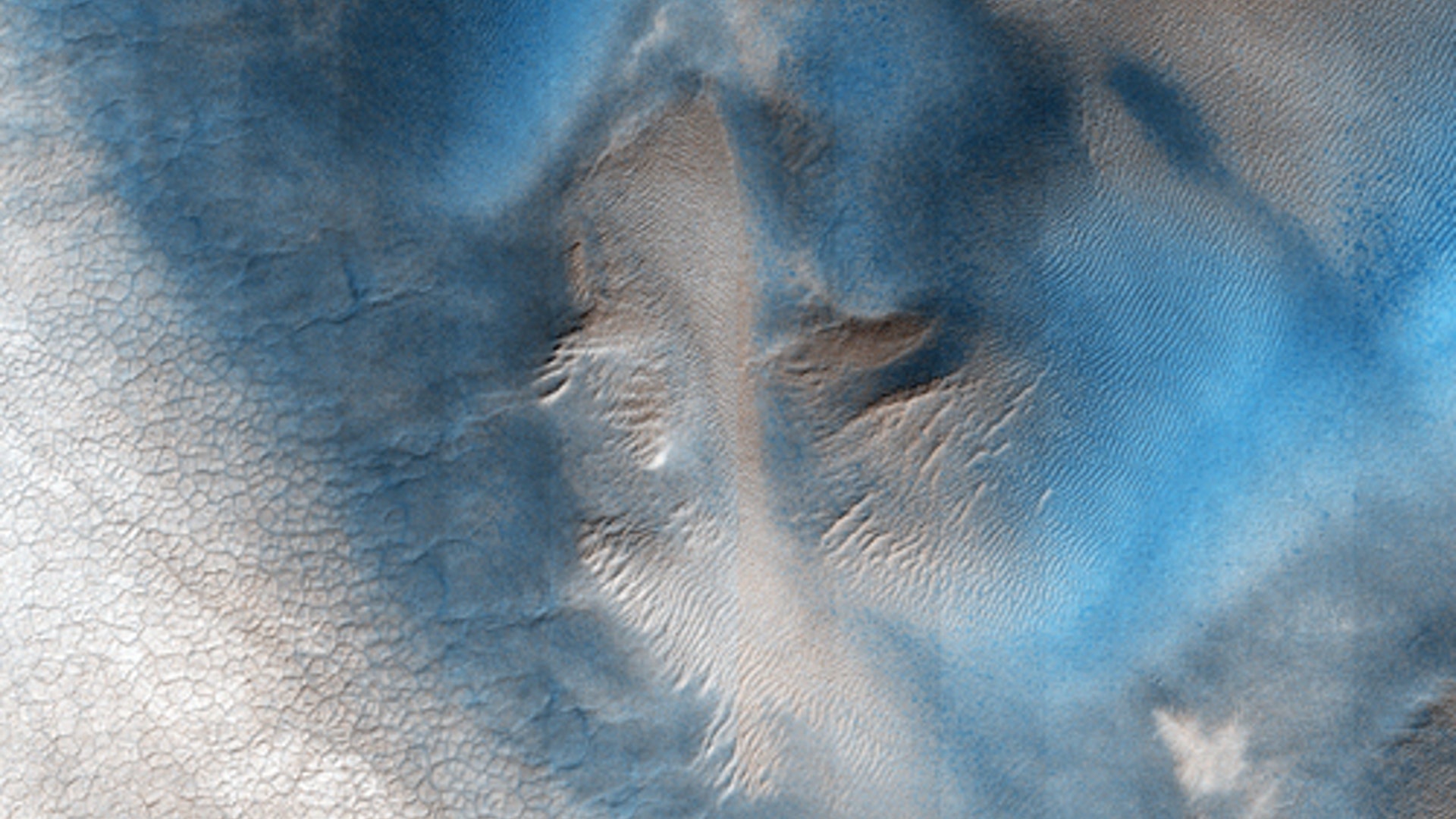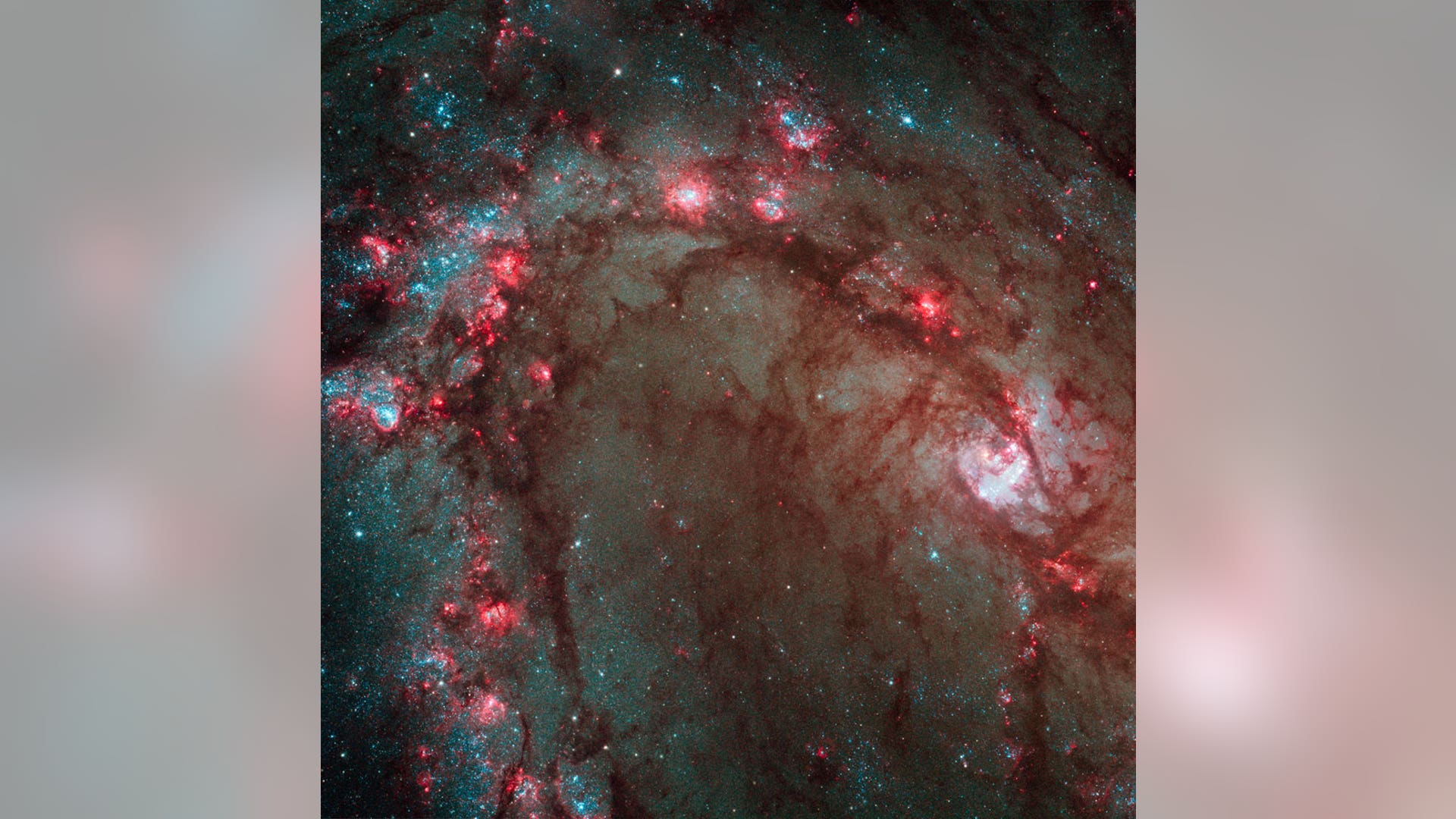Move Back
ADVERTISEMENT
Skip- Published51 Images
SpaceShots: The Week's Best Photos of Our Universe
The best space images of the week, putting you in touch with the most distant parts of the heavens.
![Icy-Hearted Earth-Like Neighbor]() Dec. 16: Astronomers have discovered the second super-Earth exoplanet for which they have determined the mass and radius, giving vital clues about its structure. It is also the first super-Earth where an atmosphere has been found. The exoplanet, orbiting a small star only 40 light-years away from us, opens up dramatic new perspectives in the quest for habitable worlds. The planet, GJ1214b, has a mass about six times that of Earth and its interior is likely to be mostly made of water ice. Its surface appears to be fairly hot and the planet is surrounded by a thick atmosphere, which makes it inhospitable for life as we know it on Earth.read moreEuropean Southern ObservatoryShare
Dec. 16: Astronomers have discovered the second super-Earth exoplanet for which they have determined the mass and radius, giving vital clues about its structure. It is also the first super-Earth where an atmosphere has been found. The exoplanet, orbiting a small star only 40 light-years away from us, opens up dramatic new perspectives in the quest for habitable worlds. The planet, GJ1214b, has a mass about six times that of Earth and its interior is likely to be mostly made of water ice. Its surface appears to be fairly hot and the planet is surrounded by a thick atmosphere, which makes it inhospitable for life as we know it on Earth.read moreEuropean Southern ObservatoryShare![Sunlight Gleams off Titan]() Dec. 17: The first flash of sunlight reflected off a lake on Saturn's moon Titan. The glint off a mirror-like surface is known as a specular reflection. This kind of glint was detected by the visual and infrared mapping spectrometer (VIMS) on NASA's Cassini spacecraft. It confirmed the presence of liquid in the moon's northern hemisphere, where lakes are more numerous and larger than those in the southern hemisphere. Scientists using VIMS had confirmed the presence of liquid in Ontario Lacus, the largest lake in the southern hemisphere, in 2008.read moreNASA/JPL/University of Arizona/DLRShare
Dec. 17: The first flash of sunlight reflected off a lake on Saturn's moon Titan. The glint off a mirror-like surface is known as a specular reflection. This kind of glint was detected by the visual and infrared mapping spectrometer (VIMS) on NASA's Cassini spacecraft. It confirmed the presence of liquid in the moon's northern hemisphere, where lakes are more numerous and larger than those in the southern hemisphere. Scientists using VIMS had confirmed the presence of liquid in Ontario Lacus, the largest lake in the southern hemisphere, in 2008.read moreNASA/JPL/University of Arizona/DLRShare![How Supernovas Stay in Shape]() Dec. 17: A new study of supernova remnants allows scientists to categorize the explosion that created them based on their shape. A team of researchers examined the shapes of 17 supernova remnants in both the Milky Way galaxy and the neighboring Large Magellanic Cloud. The results revealed that one category of supernova explosion, known as "Type Ia," generated a very symmetric, circular remnant, as seen in the Kepler supernova remnant here. This type of supernova is thought to be caused by the thermonuclear explosion of a white dwarf, and is often used by astronomers as a "standard candle" for measuring cosmic distances.read moreNASA/CXC/UCSC/L. Lopez et al.Share
Dec. 17: A new study of supernova remnants allows scientists to categorize the explosion that created them based on their shape. A team of researchers examined the shapes of 17 supernova remnants in both the Milky Way galaxy and the neighboring Large Magellanic Cloud. The results revealed that one category of supernova explosion, known as "Type Ia," generated a very symmetric, circular remnant, as seen in the Kepler supernova remnant here. This type of supernova is thought to be caused by the thermonuclear explosion of a white dwarf, and is often used by astronomers as a "standard candle" for measuring cosmic distances.read moreNASA/CXC/UCSC/L. Lopez et al.Share![How Supernovas Stay in Shape]() Dec. 17: A new study of supernova remnants allows scientists to categorize the explosion that created them based on their shape. A team of researchers examined the shapes of 17 supernova remnants in both the Milky Way galaxy and the neighboring Large Magellanic Cloud. The collapse of a very massive star results in more asymmetrically shaped remnants, as seen in this G292.0+1.8 remnant. In G292, the asymmetry is subtle but can be seen in elongated features defined by the brightest emission (colored white).read moreNASA/CXC/UCSC/L. Lopez et al.Share
Dec. 17: A new study of supernova remnants allows scientists to categorize the explosion that created them based on their shape. A team of researchers examined the shapes of 17 supernova remnants in both the Milky Way galaxy and the neighboring Large Magellanic Cloud. The collapse of a very massive star results in more asymmetrically shaped remnants, as seen in this G292.0+1.8 remnant. In G292, the asymmetry is subtle but can be seen in elongated features defined by the brightest emission (colored white).read moreNASA/CXC/UCSC/L. Lopez et al.Share![Mars Orbiter Resumes Operation]() Dec. 16: Researchers are receiving new science data from NASA's Mars Reconnaissance Orbiter after the spacecraft's six science instruments resumed observations today. Observations had been suspended since a computer reset Aug. 26. Since then, engineers have analyzed a series of previous computer resets and completed preventive care to guard against a vulnerability identified by that analysis.read moreNASA/JPLShare
Dec. 16: Researchers are receiving new science data from NASA's Mars Reconnaissance Orbiter after the spacecraft's six science instruments resumed observations today. Observations had been suspended since a computer reset Aug. 26. Since then, engineers have analyzed a series of previous computer resets and completed preventive care to guard against a vulnerability identified by that analysis.read moreNASA/JPLShare![Asteroid in the Kuiper Belt]() Dec. 16: This is an artist's impression of a one-half-mile-diameter Kuiper Belt Object (KBO) that was detected by NASA's Hubble Space Telescope. The icy relic from the early solar system is too small for Hubble to photograph. The object was detected when it passed in front of a background star, temporarily disrupting the starlight.read moreNASA, ESA, and G. Bacon (STScI)Share
Dec. 16: This is an artist's impression of a one-half-mile-diameter Kuiper Belt Object (KBO) that was detected by NASA's Hubble Space Telescope. The icy relic from the early solar system is too small for Hubble to photograph. The object was detected when it passed in front of a background star, temporarily disrupting the starlight.read moreNASA, ESA, and G. Bacon (STScI)Share![The Polar Dunes of Mars]() Dec. 16: This false-color image shows the layered deposits at top and darker materials at bottom exposed at the head of Chasma Boreale, a large canyon eroded into the layered deposits of Mars. The polar layered deposits appear red because of dust mixed within them, but are ice-rich as indicated by previous observations. The water ice in the layered deposits is probably responsible for the pattern of fractures seen near the top of the scarp. Exposures such as these are useful in understanding the recent climate variations that are likely recorded in the polar layered deposits.read moreNASA/JPL/University of ArizonaShare
Dec. 16: This false-color image shows the layered deposits at top and darker materials at bottom exposed at the head of Chasma Boreale, a large canyon eroded into the layered deposits of Mars. The polar layered deposits appear red because of dust mixed within them, but are ice-rich as indicated by previous observations. The water ice in the layered deposits is probably responsible for the pattern of fractures seen near the top of the scarp. Exposures such as these are useful in understanding the recent climate variations that are likely recorded in the polar layered deposits.read moreNASA/JPL/University of ArizonaShare![A New Crater on Mars]() Dec. 16: This impact crater is only about 18 feet across — tiny compared to the giant basins that scar most planetary bodies. This type of bowl-shaped crater is called a simple crater. It's simple compared to larger craters that have terraces, central peaks and rings, and other, more complex, shapes. But it's extremely young. The largest craters on Mars are several billion years old, but this crater formed between January 2006 and May 2008. That means it was only a few months old when photographed.read moreNASA/JPL/University of ArizonaShare
Dec. 16: This impact crater is only about 18 feet across — tiny compared to the giant basins that scar most planetary bodies. This type of bowl-shaped crater is called a simple crater. It's simple compared to larger craters that have terraces, central peaks and rings, and other, more complex, shapes. But it's extremely young. The largest craters on Mars are several billion years old, but this crater formed between January 2006 and May 2008. That means it was only a few months old when photographed.read moreNASA/JPL/University of ArizonaShare![Within the Doradus Nebula]() Dec. 15: The image from the Hubble telescope spans about 100 light-years and captures the massive, young stellar grouping called R136. It's only a few million years old and resides in the 30 Doradus Nebula, a turbulent star-birth region in the Large Magellanic Cloud, a satellite galaxy of our Milky Way. There is no known star-forming region in our galaxy as large or as prolific as 30 Doradus. Many of the diamond-like icy blue stars are among the most massive stars known. Several are over 100 times more massive than our Sun. These hefty stars are destined to pop off, like a string of firecrackers, as supernovas in a few million years.read moreNASA, ESA, and F. Paresce (INAF-IASF, Bologna, Italy), R. O'Connell (University of Virginia, Charlottesville), and the Wide Field Camera 3 Science Oversight CommitteeShare
Dec. 15: The image from the Hubble telescope spans about 100 light-years and captures the massive, young stellar grouping called R136. It's only a few million years old and resides in the 30 Doradus Nebula, a turbulent star-birth region in the Large Magellanic Cloud, a satellite galaxy of our Milky Way. There is no known star-forming region in our galaxy as large or as prolific as 30 Doradus. Many of the diamond-like icy blue stars are among the most massive stars known. Several are over 100 times more massive than our Sun. These hefty stars are destined to pop off, like a string of firecrackers, as supernovas in a few million years.read moreNASA, ESA, and F. Paresce (INAF-IASF, Bologna, Italy), R. O'Connell (University of Virginia, Charlottesville), and the Wide Field Camera 3 Science Oversight CommitteeShare![NASA's Sky Mapper Takes Off]() Dec. 14: NASA's Wide-field Infrared Survey Explorer, or WISE, launched aboard a United Launch Alliance Delta II rocket at 9:09 a.m. EST from Space Launch Complex-2 at Vandenberg Air Force Base. WISE will scan the entire sky in infrared light, picking up the glow of hundreds of millions of objects and producing millions of images.read moreBill Hartenstein/United Launch AllianceShare
Dec. 14: NASA's Wide-field Infrared Survey Explorer, or WISE, launched aboard a United Launch Alliance Delta II rocket at 9:09 a.m. EST from Space Launch Complex-2 at Vandenberg Air Force Base. WISE will scan the entire sky in infrared light, picking up the glow of hundreds of millions of objects and producing millions of images.read moreBill Hartenstein/United Launch AllianceShare![When Galaxies Collide]() Dec. 10: This composite image from three different telescopes shows an ongoing collision between two galaxies. Astronomers think that supermassive black holes exist at the center of most galaxies. Not only do the galaxies and black holes seem to co-exist, they are apparently inextricably linked in their evolution. To better understand this symbiotic relationship, scientists have turned to rapidly growing black holes — so-called active galactic nucleus — to study how they are affected by their galactic environments.read moreX-ray: NASA/CXC/SAO/M.Machacek; Optical: ESO/VLT; Infrared: NASA/JPL/CaltechShare
Dec. 10: This composite image from three different telescopes shows an ongoing collision between two galaxies. Astronomers think that supermassive black holes exist at the center of most galaxies. Not only do the galaxies and black holes seem to co-exist, they are apparently inextricably linked in their evolution. To better understand this symbiotic relationship, scientists have turned to rapidly growing black holes — so-called active galactic nucleus — to study how they are affected by their galactic environments.read moreX-ray: NASA/CXC/SAO/M.Machacek; Optical: ESO/VLT; Infrared: NASA/JPL/CaltechShare![Missile Launch Lights up Norway]() Dec. 10: The failure of a new Russian intercontinental ballistic missile during testing was the cause of spectacular spiraling blue lights in the skies over northern Norway. Speculation of UFOs activity swirled, but military analysts said the lights were clearly the result of the Bulava missle's explosion. This kind of light show comes from a failed missile launch," said Pavel Felgenhauer, an independent military analyst. "Russia has run free fireworks for the Norwegians."read moreDagfinn RappShare
Dec. 10: The failure of a new Russian intercontinental ballistic missile during testing was the cause of spectacular spiraling blue lights in the skies over northern Norway. Speculation of UFOs activity swirled, but military analysts said the lights were clearly the result of the Bulava missle's explosion. This kind of light show comes from a failed missile launch," said Pavel Felgenhauer, an independent military analyst. "Russia has run free fireworks for the Norwegians."read moreDagfinn RappShare![Orion’s Belt and the Flame Nebula]() Dec. 10: This spectacular visible light wide-field view of part of the famous belt of the great celestial hunter Orion shows the region of the sky around the Flame Nebula. The whole image is filled with glowing gas clouds illuminated by hot blue young stars. It was created from photographs in red and blue light forming part of the Digitized Sky Survey 2. The field of view is approximately three degrees.read moreESO and Digitized Sky Survey 2. Acknowledgment: Davide De MartinShare
Dec. 10: This spectacular visible light wide-field view of part of the famous belt of the great celestial hunter Orion shows the region of the sky around the Flame Nebula. The whole image is filled with glowing gas clouds illuminated by hot blue young stars. It was created from photographs in red and blue light forming part of the Digitized Sky Survey 2. The field of view is approximately three degrees.read moreESO and Digitized Sky Survey 2. Acknowledgment: Davide De MartinShare![Satellite Marks 10 Years in Space]() Dec. 10: One of the most successful European space missions is celebrating its birthday: the XMM-Newton X-ray observatory marks 10 years mark in space. On 10 December 1999, an Ariane 5 rocket launched the 33-foot tall, 4-ton research satellite for the European Space Agency (ESA). It now ranks among the most successful space observatories.read moreEADS AstriumShare
Dec. 10: One of the most successful European space missions is celebrating its birthday: the XMM-Newton X-ray observatory marks 10 years mark in space. On 10 December 1999, an Ariane 5 rocket launched the 33-foot tall, 4-ton research satellite for the European Space Agency (ESA). It now ranks among the most successful space observatories.read moreEADS AstriumShare![Saturn's Moon in Black and White]() Dec. 10: New data from NASA's Cassini spacecraft at Saturn helps explain the bizarre yin-yang appearance of the ringed planet's odd moon Iapetus, where one side is dark and the other is bright. The images and heat-mapping data collected by Cassini support the leading explanation of the moon's strange appearance, which suggests that migrating ice makes half the moon reflective and bright, while the other half is dust-covered and dark.read moreNASA/JPL/Space Science InstituteShare
Dec. 10: New data from NASA's Cassini spacecraft at Saturn helps explain the bizarre yin-yang appearance of the ringed planet's odd moon Iapetus, where one side is dark and the other is bright. The images and heat-mapping data collected by Cassini support the leading explanation of the moon's strange appearance, which suggests that migrating ice makes half the moon reflective and bright, while the other half is dust-covered and dark.read moreNASA/JPL/Space Science InstituteShare![Snow Blankets the U.S.]()
![Saturn Has a Hexagon]() Dec. 9: As Saturn's north pole emerged from winter darkness, Cassini captured new details of a jet stream that follows a hexagon-shaped path and has long puzzled scientists. As the planet approached its equinox (signaled the start of northern spring), the whole hexagonal shape could be mapped out in visible light for the first time. The hexagon is likely formed by the path of a jet stream flowing around the planet's north pole.read moreNASA/JPL/Space Science InstituteShare
Dec. 9: As Saturn's north pole emerged from winter darkness, Cassini captured new details of a jet stream that follows a hexagon-shaped path and has long puzzled scientists. As the planet approached its equinox (signaled the start of northern spring), the whole hexagonal shape could be mapped out in visible light for the first time. The hexagon is likely formed by the path of a jet stream flowing around the planet's north pole.read moreNASA/JPL/Space Science InstituteShare![Mars Orbiter Moves On]() Dec. 8: NASA's Mars Reconnaissance Orbiter today has been taken out of the precautionary "safe mode" it had been in since August. Taking the spacecraft out of safe mode is the latest step in a series of commands that are being sent to the orbiter this week. Engineers plan to resume science operations once they conclude a check of all the science instruments. Normal science operations may resume next week.read moreNASA/JPLShare
Dec. 8: NASA's Mars Reconnaissance Orbiter today has been taken out of the precautionary "safe mode" it had been in since August. Taking the spacecraft out of safe mode is the latest step in a series of commands that are being sent to the orbiter this week. Engineers plan to resume science operations once they conclude a check of all the science instruments. Normal science operations may resume next week.read moreNASA/JPLShare![Virgin Galactic's SpaceShipTwo]() Nov. 7: SpaceShipTwo is a carbon composite cousin in construction and design to SpaceShipOne — the privately financed, single-piloted spacecraft that bagged the $10 million Ansari X Prize purse by flying back-to-back treks to suborbital space in 2004. Richard Branson's Virgin Galactic finally unveiled the new ship, which will be the keystone in his plan to corner the tourists-in-space market.read moreVirgin Galactic/Ned RocknRollShare
Nov. 7: SpaceShipTwo is a carbon composite cousin in construction and design to SpaceShipOne — the privately financed, single-piloted spacecraft that bagged the $10 million Ansari X Prize purse by flying back-to-back treks to suborbital space in 2004. Richard Branson's Virgin Galactic finally unveiled the new ship, which will be the keystone in his plan to corner the tourists-in-space market.read moreVirgin Galactic/Ned RocknRollShare![Transporting a Telescope]() Dec. 7: European Space Organization (ESO) astronomer Yuri Beletsky captured images of the transport of one of the 6-foot telescopes that compose, together with their larger 27-foot companions, ESO’s Very Large Telescope array. The telescope was moved with the utmost care from base camp, where it had been undergoing maintenance, including the recoating of its mirrors, back to the VLT platform on top of Cerro Paranal.read moreESO/Y. BeletskyShare
Dec. 7: European Space Organization (ESO) astronomer Yuri Beletsky captured images of the transport of one of the 6-foot telescopes that compose, together with their larger 27-foot companions, ESO’s Very Large Telescope array. The telescope was moved with the utmost care from base camp, where it had been undergoing maintenance, including the recoating of its mirrors, back to the VLT platform on top of Cerro Paranal.read moreESO/Y. BeletskyShare![Subaru Finds a Planet]() Dec. 3: The first observations with the world's newest planet-hunter instrument on Japan's Subaru Telescope, HiCIAO (High Contrast Instrument for the Subaru next generation Adaptive Optics), have revealed a new exo-planet: a companion to the Sun-like star GJ 758. With an estimated mass 10 to 40 times that of Jupiter, GJ 758 B is either a giant planet or a lightweight brown dwarf. Without the scope's angular differential imaging, the star's speckle halo (the burst-like feature in the center) would overwhelm the signals from the planet.read moreSubaru Telescope, National Astronomical Observatory of Japan (NAOJ)Share
Dec. 3: The first observations with the world's newest planet-hunter instrument on Japan's Subaru Telescope, HiCIAO (High Contrast Instrument for the Subaru next generation Adaptive Optics), have revealed a new exo-planet: a companion to the Sun-like star GJ 758. With an estimated mass 10 to 40 times that of Jupiter, GJ 758 B is either a giant planet or a lightweight brown dwarf. Without the scope's angular differential imaging, the star's speckle halo (the burst-like feature in the center) would overwhelm the signals from the planet.read moreSubaru Telescope, National Astronomical Observatory of Japan (NAOJ)Share![Star Cluster Trumper 14]() Dec. 3: Trumpler 14 is not only the youngest, but also one of the most populous clusters within the nebula. Astronomers counted about 2,000 stars in the very central parts of this cluster. This image so far covers the widest area of the sky, and is based on data obtained through two different filters.read moreESOShare
Dec. 3: Trumpler 14 is not only the youngest, but also one of the most populous clusters within the nebula. Astronomers counted about 2,000 stars in the very central parts of this cluster. This image so far covers the widest area of the sky, and is based on data obtained through two different filters.read moreESOShare![Soyuz TMA-15 Capsule]()
![Soufriere Hills Volcano]() November 28: Activity at Montserrat’s Soufrière Hills Volcano continues to ebb and flow. Growth of the lava dome on the volcano’s summit has led to numerous pyroclastic flows, some of which nearly reached the ocean. NASA’s Aqua satellite snapped this natural-color image at 1:40 PM local time; roughly 3 hours before, the Air Force Weather Agency reported an ash plume reaching to flight level 120.read moreJeff Schmaltz, MODIS Land Rapid Response Team, NASA GSFCShare
November 28: Activity at Montserrat’s Soufrière Hills Volcano continues to ebb and flow. Growth of the lava dome on the volcano’s summit has led to numerous pyroclastic flows, some of which nearly reached the ocean. NASA’s Aqua satellite snapped this natural-color image at 1:40 PM local time; roughly 3 hours before, the Air Force Weather Agency reported an ash plume reaching to flight level 120.read moreJeff Schmaltz, MODIS Land Rapid Response Team, NASA GSFCShare![Japanese Spy Satellite]()
![Atlantis in Space]() Nov. 25: Surrounded by the blackness of space, this profile view of the space shuttle Atlantis was photographed by the Expedition 21 crew on the International Space Station soon after the shuttle and station began their post-undocking relative separation. Undocking of the two spacecraft occurred at 3:53 a.m. CST on Nov. 25. Atlantis and the STS-129 crew landed safely at Kennedy Space Center two days later.read moreNASAShare
Nov. 25: Surrounded by the blackness of space, this profile view of the space shuttle Atlantis was photographed by the Expedition 21 crew on the International Space Station soon after the shuttle and station began their post-undocking relative separation. Undocking of the two spacecraft occurred at 3:53 a.m. CST on Nov. 25. Atlantis and the STS-129 crew landed safely at Kennedy Space Center two days later.read moreNASAShare![Gullies on Mars]() Nov. 25: The Mars Reconnaissance Orbiter's HiRISE camera documents a variety of gullies on Mars. Some hypotheses about their formation involve the flow of liquid (water, brine or some other substance). Other postulates involve the downhill movement of dry material such as dust or sand. To further complicate things, different gullies could have formed by different methods.read moreNASA/JPL/University of ArizonaShare
Nov. 25: The Mars Reconnaissance Orbiter's HiRISE camera documents a variety of gullies on Mars. Some hypotheses about their formation involve the flow of liquid (water, brine or some other substance). Other postulates involve the downhill movement of dry material such as dust or sand. To further complicate things, different gullies could have formed by different methods.read moreNASA/JPL/University of ArizonaShare![Atlas V Launch]()
![Crab Nebula]() Nov. 23: A star's spectacular death in the constellation Taurus was observed on Earth as the supernova of 1054 A.D. Now, almost a thousand years later, a super dense object left behind by the explosion—called a neutron star—is seen spewing out a blizzard of high-energy particles into the expanding debris field known as the Crab Nebula. X-ray data from Chandra provide significant clues to the workings of this mighty cosmic "generator," which is producing energy at the rate of 100,000 suns.read moreX-ray: NASA/CXC/SAO/F.Seward; Optical: NASA/ESA/ASU/J.Hester & A.Loll; Infrared: NASA/JPL-Caltech/Univ. Minn./R.GehrzShare
Nov. 23: A star's spectacular death in the constellation Taurus was observed on Earth as the supernova of 1054 A.D. Now, almost a thousand years later, a super dense object left behind by the explosion—called a neutron star—is seen spewing out a blizzard of high-energy particles into the expanding debris field known as the Crab Nebula. X-ray data from Chandra provide significant clues to the workings of this mighty cosmic "generator," which is producing energy at the rate of 100,000 suns.read moreX-ray: NASA/CXC/SAO/F.Seward; Optical: NASA/ESA/ASU/J.Hester & A.Loll; Infrared: NASA/JPL-Caltech/Univ. Minn./R.GehrzShare![Earth from the Space Station]() Nov. 22: One of many breathtaking views from the International Space Station. The Sun, a crescent Earth, and the long arm of a solar panel were all visible outside a window when the Space Shuttle Atlantis visited the orbiting outpost last week. Reflections from the window and hexagonal lens flares from the camera are superposed. The space shuttle landed Friday after a successful 10 day mission to expand and resupply the ISS.read moreSTS-129 Crew, NASAShare
Nov. 22: One of many breathtaking views from the International Space Station. The Sun, a crescent Earth, and the long arm of a solar panel were all visible outside a window when the Space Shuttle Atlantis visited the orbiting outpost last week. Reflections from the window and hexagonal lens flares from the camera are superposed. The space shuttle landed Friday after a successful 10 day mission to expand and resupply the ISS.read moreSTS-129 Crew, NASAShare![Atlantis Spacewalk]()
![WISE Maps the Sky]()
![Shuttle Atlantis in Space]() Nov. 17: Backdropped by a blue and white Earth, a partial view of Space Shuttle Atlantis' payload bay, vertical stabilizer, orbital maneuvering system (OMS) pods and docking mechanism are featured in this image photographed by an STS-129 crew member from an aft flight deck window.read moreNASA TVShare
Nov. 17: Backdropped by a blue and white Earth, a partial view of Space Shuttle Atlantis' payload bay, vertical stabilizer, orbital maneuvering system (OMS) pods and docking mechanism are featured in this image photographed by an STS-129 crew member from an aft flight deck window.read moreNASA TVShare![The Oldest Light in the Universe]() NASA's Cosmic Background Explorer (COBE) satellite rocketed into Earth orbit on Nov. 18, 1989, and quickly revolutionized our understanding of the early cosmos. Developed and built at Goddard Space Flight Center in Greenbelt, Md., COBE precisely measured and mapped the oldest light in the universe — the cosmic microwave background. For these results, COBE scientists John Mather, at Goddard, and George Smoot, at the University of California, Berkeley, shared the 2006 Nobel Prize in physics. The mission ushered cosmologists into a new era of precision measurements, paving the way for deeper exploration of the microwave background by NASA's ongoing WMAP mission and the European Space Agency's new Planck satellite.read more
NASA's Cosmic Background Explorer (COBE) satellite rocketed into Earth orbit on Nov. 18, 1989, and quickly revolutionized our understanding of the early cosmos. Developed and built at Goddard Space Flight Center in Greenbelt, Md., COBE precisely measured and mapped the oldest light in the universe — the cosmic microwave background. For these results, COBE scientists John Mather, at Goddard, and George Smoot, at the University of California, Berkeley, shared the 2006 Nobel Prize in physics. The mission ushered cosmologists into a new era of precision measurements, paving the way for deeper exploration of the microwave background by NASA's ongoing WMAP mission and the European Space Agency's new Planck satellite.read more![Hosting Destruction]() This artist's concept illustrates the two types of spiral galaxies that populate our universe: those with plump middles, or central bulges (upper left), and those lacking the bulge (foreground). New observations from NASA's Spitzer Space Telescope provide strong evidence that the slender, bulgeless galaxies can, like their chubbier counterparts, harbor supermassive black holes at their cores. Previously, astronomers thought that a galaxy without a bulge could not have a supermassive black hole. In this illustration, jets shooting away from the black holes are depicted as thin streams. The findings are reshaping theories of galaxy formation, suggesting that a galaxy's "waistline" does not determine whether it will be home to a big black hole.read more
This artist's concept illustrates the two types of spiral galaxies that populate our universe: those with plump middles, or central bulges (upper left), and those lacking the bulge (foreground). New observations from NASA's Spitzer Space Telescope provide strong evidence that the slender, bulgeless galaxies can, like their chubbier counterparts, harbor supermassive black holes at their cores. Previously, astronomers thought that a galaxy without a bulge could not have a supermassive black hole. In this illustration, jets shooting away from the black holes are depicted as thin streams. The findings are reshaping theories of galaxy formation, suggesting that a galaxy's "waistline" does not determine whether it will be home to a big black hole.read more![The International Space Station]()
![The Atlantis Shuttle Blasts Off]() Nov. 16: Space shuttle Atlantis rises from Launch Pad 39A at NASA's Kennedy Space Center in Florida. Liftoff on its STS-129 mission came at 2:28 p.m. EST. Aboard are crew members Commander Charles O. Hobaugh; Pilot Barry E. Wilmore; and Mission Specialists Leland Melvin, Randy Bresnik, Mike Foreman and Robert L. Satcher Jr.read moreNASA/Sandra Joseph and Kevin O'ConnellShare
Nov. 16: Space shuttle Atlantis rises from Launch Pad 39A at NASA's Kennedy Space Center in Florida. Liftoff on its STS-129 mission came at 2:28 p.m. EST. Aboard are crew members Commander Charles O. Hobaugh; Pilot Barry E. Wilmore; and Mission Specialists Leland Melvin, Randy Bresnik, Mike Foreman and Robert L. Satcher Jr.read moreNASA/Sandra Joseph and Kevin O'ConnellShare![Clouds over the South Pacific]() Nov. 13: The European Space Agency's Rosetta satellite turned its high-resolution cameras back on plaent Earth to capture this picture of a swirling anticyclone over the South Pacific. The satellite will then go on to study asteroid Lutetia and ultimately comet 67P/Churyumov-Gerasimenko.read moreEuropean Space AgencyShare
Nov. 13: The European Space Agency's Rosetta satellite turned its high-resolution cameras back on plaent Earth to capture this picture of a swirling anticyclone over the South Pacific. The satellite will then go on to study asteroid Lutetia and ultimately comet 67P/Churyumov-Gerasimenko.read moreEuropean Space AgencyShare![OSIRIS Captures Earth]()
![Rosetta Captures Earth]() The European Space Agency's Rosetta satellite turned its high-resolution cameras back on planet Earth to capture this picture of our cloud covered planet from approximately 224,000 km away. The satellite will then go on to study asteroid Lutetia and ultimately comet 67P/Churyumov-Gerasimenko.read moreEuropean Space AgencyShare
The European Space Agency's Rosetta satellite turned its high-resolution cameras back on planet Earth to capture this picture of our cloud covered planet from approximately 224,000 km away. The satellite will then go on to study asteroid Lutetia and ultimately comet 67P/Churyumov-Gerasimenko.read moreEuropean Space AgencyShare![Burning Lithium in a Star]() Artist’s impression of a baby star still surrounded by a protoplanetary disc in which planets are forming. Using ESO’s very successful HARPS spectrograph, a team of astronomers has found that Sun-like stars which host planets have destroyed their lithium much more efficiently than planet-free stars.read moreEuropean Southern ObservatoryShare
Artist’s impression of a baby star still surrounded by a protoplanetary disc in which planets are forming. Using ESO’s very successful HARPS spectrograph, a team of astronomers has found that Sun-like stars which host planets have destroyed their lithium much more efficiently than planet-free stars.read moreEuropean Southern ObservatoryShare![Galaxies Fat and Thin]() This artist's concept illustrates the two types of spiral galaxies that populate our universe: those with plump middles, or central bulges (upper left), and those lacking the bulge (foreground). New observations from NASA's Spitzer Space Telescope provide strong evidence that the slender, bulgeless galaxies can, like their chubbier counterparts, harbor supermassive black holes at their cores. Previously, astronomers thought that a galaxy without a bulge could not have a supermassive black hole.read moreNASAShare
This artist's concept illustrates the two types of spiral galaxies that populate our universe: those with plump middles, or central bulges (upper left), and those lacking the bulge (foreground). New observations from NASA's Spitzer Space Telescope provide strong evidence that the slender, bulgeless galaxies can, like their chubbier counterparts, harbor supermassive black holes at their cores. Previously, astronomers thought that a galaxy without a bulge could not have a supermassive black hole.read moreNASAShare![Dying Star]() Probing a glowing bubble of gas and dust encircling a dying star, NASA's Hubble Space Telescope reveals a wealth of previously unseen structures. The object, called NGC 2371, is a planetary nebula, the glowing remains of a sun-like star. The remnant star visible at the center of NGC 2371 is the super-hot core of the former red giant, now stripped of its outer layers. Its surface temperature is a scorching 240,000 degrees Fahrenheit.read moreNASA, ESA and the Hubble Heritage Team (STScI/AURA)Share
Probing a glowing bubble of gas and dust encircling a dying star, NASA's Hubble Space Telescope reveals a wealth of previously unseen structures. The object, called NGC 2371, is a planetary nebula, the glowing remains of a sun-like star. The remnant star visible at the center of NGC 2371 is the super-hot core of the former red giant, now stripped of its outer layers. Its surface temperature is a scorching 240,000 degrees Fahrenheit.read moreNASA, ESA and the Hubble Heritage Team (STScI/AURA)Share![Milky Way Panorama]() The Milky Way arches across this 360-degree panorama of the night sky above the ESO’s Very Large Telescope. The image was made from 37 individual frames with a total exposure time of about 30 minutes, taken in the early morning hours. The Moon is just rising and the zodiacal light shines above it, while the Milky Way stretches across the sky opposite the observatory. The open telescope domes of the observatory's ground-based astronomical observatory are all visible here.read moreEuropean Southern ObservatoryShare
The Milky Way arches across this 360-degree panorama of the night sky above the ESO’s Very Large Telescope. The image was made from 37 individual frames with a total exposure time of about 30 minutes, taken in the early morning hours. The Moon is just rising and the zodiacal light shines above it, while the Milky Way stretches across the sky opposite the observatory. The open telescope domes of the observatory's ground-based astronomical observatory are all visible here.read moreEuropean Southern ObservatoryShare![Driving on Mars]() NASA's Mars Exploration Rover Opportunity photographs tracks it left on Mars by backing out of a wind-formed ripple, after the rover's wheels had started to dig too deeply into the dust and sand of the ripple. For scale, the distance between the parallel wheel tracks is about about 40 inches.read moreNASA/JPL-CaltechShare
NASA's Mars Exploration Rover Opportunity photographs tracks it left on Mars by backing out of a wind-formed ripple, after the rover's wheels had started to dig too deeply into the dust and sand of the ripple. For scale, the distance between the parallel wheel tracks is about about 40 inches.read moreNASA/JPL-CaltechShare![Central Region of the Milky Way]() In this spectacular image, observations using infrared and X-ray light see through the obscuring dust and reveal the intense activity near the galactic core of the Milky Way. The image combines pictures from the Hubble Space Telescope, Spitzer Space Telescope and Chandra X-ray Observatory.read moreNASA, ESA, SSC, CXC, and STScIShare
In this spectacular image, observations using infrared and X-ray light see through the obscuring dust and reveal the intense activity near the galactic core of the Milky Way. The image combines pictures from the Hubble Space Telescope, Spitzer Space Telescope and Chandra X-ray Observatory.read moreNASA, ESA, SSC, CXC, and STScIShare![Frost Caps on Mars]() As on Earth, the seasonal frost caps of Mars grow and recede each year. But seasonal frost on Mars is composed of carbon dioxide ice (also known as dry ice), not water ice as on our planet. This image shows part of the south polar residual cap, with many shallow pits dubbed "Swiss cheese" terrain. Because the sun is always low in the sky at this latitude, the steep walls of the pits receive more solar energy than the high-standing, flat areas between the pits. This causes the walls of the pits to retreat several meters per year as sunlight causes the carbon dioxide ice to evaporate directly to gas, a process called sublimation.read moreNASA/JPL/University of ArizonaShare
As on Earth, the seasonal frost caps of Mars grow and recede each year. But seasonal frost on Mars is composed of carbon dioxide ice (also known as dry ice), not water ice as on our planet. This image shows part of the south polar residual cap, with many shallow pits dubbed "Swiss cheese" terrain. Because the sun is always low in the sky at this latitude, the steep walls of the pits receive more solar energy than the high-standing, flat areas between the pits. This causes the walls of the pits to retreat several meters per year as sunlight causes the carbon dioxide ice to evaporate directly to gas, a process called sublimation.read moreNASA/JPL/University of ArizonaShare![Sand Dunes on Mars]()
![Martian Dust Devils]() The HiRISE camera on the Mars Reconnaissance Orbiter shows twisting dark trails criss-crossing light-colored terrain on the Martian surface. Newly formed trails like these had presented researchers with a tantalizing mystery but are now known to be the work of miniature wind vortices known to occur on the red planet — in other words, Martian dust devils.read moreNASAShare
The HiRISE camera on the Mars Reconnaissance Orbiter shows twisting dark trails criss-crossing light-colored terrain on the Martian surface. Newly formed trails like these had presented researchers with a tantalizing mystery but are now known to be the work of miniature wind vortices known to occur on the red planet — in other words, Martian dust devils.read moreNASAShare![Birth of a Star]() The spectacular new camera installed on NASA's Hubble Space Telescope delivered the most detailed view of star birth in the graceful, curving arms of the nearby spiral galaxy M83. Nicknamed the Southern Pinwheel, M83 is undergoing more rapid star formation than our own Milky Way galaxy, especially in its nucleus. Wide Field Camera 3 has captured hundreds of young star clusters, ancient swarms of globular star clusters, and hundreds of thousands of individual stars, mostly blue supergiants and red supergiants. The image, taken in August 2009, provides a close-up view of the myriad stars near the galaxy's core, the bright whitish region at far right.read moreNASAShare
The spectacular new camera installed on NASA's Hubble Space Telescope delivered the most detailed view of star birth in the graceful, curving arms of the nearby spiral galaxy M83. Nicknamed the Southern Pinwheel, M83 is undergoing more rapid star formation than our own Milky Way galaxy, especially in its nucleus. Wide Field Camera 3 has captured hundreds of young star clusters, ancient swarms of globular star clusters, and hundreds of thousands of individual stars, mostly blue supergiants and red supergiants. The image, taken in August 2009, provides a close-up view of the myriad stars near the galaxy's core, the bright whitish region at far right.read moreNASAShare![Rhea, Saturn's Second Largest Moon]()
- Published51 Images
SpaceShots: The Week's Best Photos of Our Universe
The best space images of the week, putting you in touch with the most distant parts of the heavens.
Move Forward
- SpaceShots: The Week's Best Photos of Our Universe



















































Thumbnail View
Image 0 of 51
